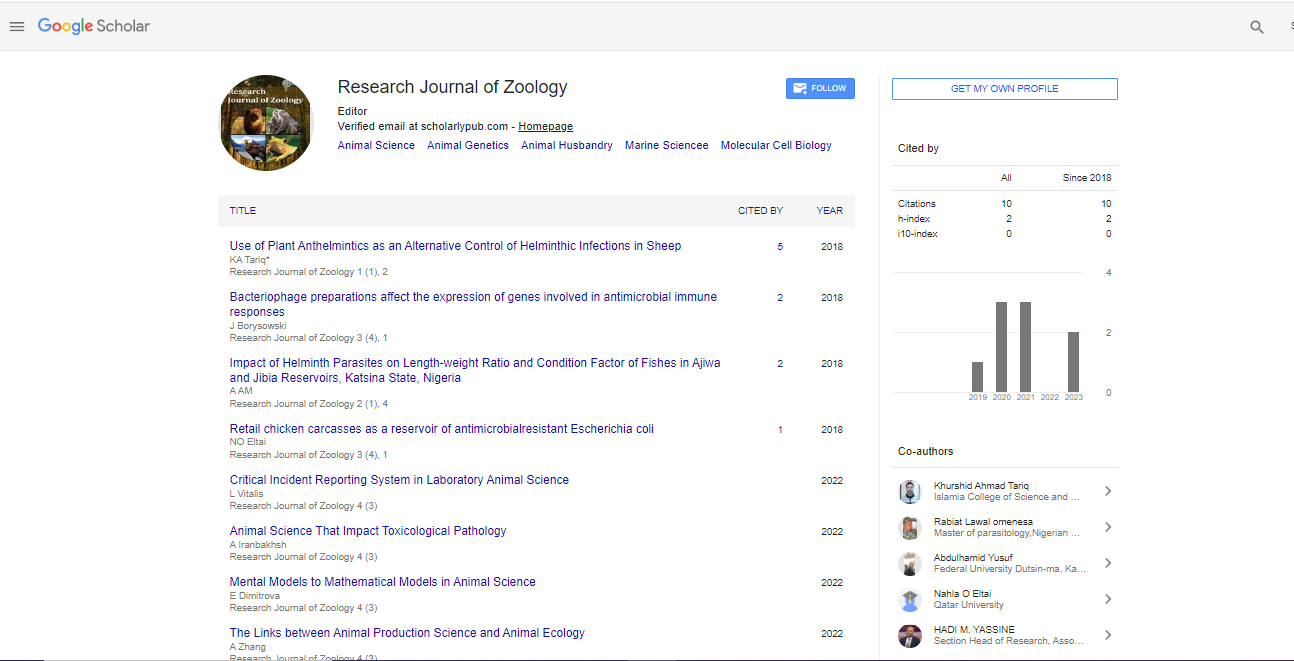Opinion Article, Res J Zool Vol: 5 Issue: 4
Mechanism of Genetic Symphony of the Animal World
Alami Samaina*
1Department of Genetics, University of British Columbia, Vancouver, Canada
*Corresponding Author: Alami Samaina,
Department of Genetics, University of
British Columbia, Vancouver, Canada
E-mail: samaina.ala@gmail.com
Received date: 21 November, 2023, Manuscript No. RJZ-24-128387;
Editor assigned date: 23 November, 2023, PreQC No. RJZ-24-128387 (PQ);
Reviewed date: 07 December, 2023, QC No. RJZ-24-128387;
Revised date: 15 December, 2023, Manuscript No. RJZ-24-128387 (R);
Published date: 22 December, 2023, DOI: 10.4172/RJZ.1000096.
Citation: Samaina A (2023) Mechanism of Genetic Symphony of the Animal World. Res J Zool 5:4.
Description
Every living organization contains a complicated code, a collection of instructions that determines its structure, function, and behavior. DNA is a complicated code, provides an essential to recognizing the unity and diversity. In order to regulate the efforts towards the animal world, the study of animal genetics becomes a direction to identifying the mysteries of evolution, adaptation, and the fundamental characteristics that identifies every organism.
Animal genetics found the fundamental molecule of life, deoxyribonucleic acid, (DNA). This double-helix structure, elegantly elucidated by James Watson and Francis Crick, serves as the blueprint for the development, growth, and functioning of all living organisms. In the context of the animal kingdom, DNA is the complicated language that coordinate the symphony of life, encoding the information that shapes the myriad forms and functions observed in diverse organisms.
Heredity and inheritance
The study of animal genetics begins with the concept of heredity, the transmission of genetic information from one generation to the next generation. Genes, the segments of DNA that carry specific instructions for the synthesis of proteins, serve as the units of heredity. Through the process of reproduction, genetic material is passed on, shaping the abilities and characteristics of the children.
Mendelian genetics, based on the pioneering work of Gregor Mendel, provides a foundational understanding of how abilities are inherited. Mendel's laws of segregation and independent assortment explain the patterns of inheritance for single-gene abilities, providing insights into the transmission of abilities such as coat color in mammals or wing size in insects. However, the genetic landscape is significantly more intricate than Mendel's peas, with many abilities influenced by multiple genes and environmental factors.
Genetic variation and diversity
The animal kingdom's complexity originates from its incredible diversity, which can be demonstrated by differences accumulated within the different DNA organisms. Genetic variation is the cause for adaptation and evolution, allowing populations to respond the environmental challenges and changes over time.
Mutation, a spontaneous change in DNA sequence, is a primary source of genetic variation. While some mutations may be detrimental, others contribute to the diversity and resilience of populations. Natural selection acts upon this variation, characteristics that enhance an organism's survival and reproductive success. Over successive generations, this process leads to the gradual evolution of organisms, exemplified by the myriad adaptations seen in animals ranging from the explosive cheetah to the stealthy chameleon.
Genetic regulation and expression
The complexity of animal genetics extends additional to the structure of DNA to the complicated processes of gene regulation and expression. All genes are active all the time and their activity is tightly regulated, allowing cells to respond dynamically to internal and external signals.
Epigenetics, a developing field within genetics, explores how external factors such as diet, stress, and environmental exposures can influence gene expression without altering the underlying DNA sequence. This dynamic interplay between genes and the environment adds an additional layer of complexity to the understanding of how genetic information is translated into observable characteristics.
Selective breeding and domestication
Human intervention has played a significant role in shaping the genetics of domesticated animals through selective breeding. Over centuries, humans have selectively bred animals for specific traits, leading to the development of diverse breeds specific for various functions, from agriculture to human interaction.
For example, the domestication of dogs emphasizes their enormous impact of selective breeding on genetics. A wide range of dog breeds reflects the manipulation of genetic variation to accentuate specific physical and behavioral abilities. However, the consequences of selective breeding also raise ethical considerations, as some breeds may be prone to genetic disorders due to the concentration of specific abilities.
 Spanish
Spanish  Chinese
Chinese  Russian
Russian  German
German  French
French  Japanese
Japanese  Portuguese
Portuguese  Hindi
Hindi 
